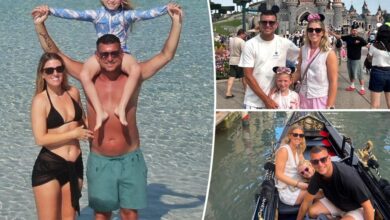Stream It Or Skip It?
You likely know the remarkable story of four Colombian children who survived a plane crash and 40 days alone in the Amazon rainforest in 2023, since Lost in the Jungle (now streaming on Disney+) is the third documentary, for three different streaming services, chronicling the ordeal. Netflix produced The Lost Children and HBO gave us Lost in the Amazon: The Rescue That Shocked the World, both in 2024, but Lost in the Jungle likely boasts the strongest filmmaker pedigree in co-directors Jimmy Chin and Elizabeth Chai Vasarhelyi, who won a best documentary Oscar for 2019’s Free Solo, and also helmed acclaimed Diana Nyad biopic Nyad in 2023. Here they collaborate with a third director, Juan Camilo Cruz (Country of Lost Children), piecing together an artful retelling of a deceptively complex story about not just survival, but clashing cultures and domestic strife, adding further depth and shade to what’s likely already familiar to you.
The Gist: Lesly was 13 when she boarded a Cessna aircraft for Bogota with her mother and siblings. She narrates solemnly about how they were going to live with her stepfather; she was happy at home with her grandmother, and didn’t want to go. Her mother, Magdalena, was 33; her sister Soleiny was nine, brother Tien was five and baby sister Cristin was 11 months. They weren’t far into their journey when the plane began to malfunction. The pilot lost control. The craft plummeted into the jungle and when Lesly awoke, she was bleeding from her head, her leg throbbing in pain. She found Cristin wailing beneath their mother’s lifeless body. The pilot and a third adult on board were dead. Soleiny and Tien were also alive. She gathered her brother and sisters and made a bed of leaves for them to lay on. “So much blood,” Lesly narrates. “So much pain.” We see animated pencil-like drawings of the children, weary and scared, moving atop still shots of the Amazon jungle. They’re alone. So alone.
This patch of jungle is remarkably treacherous. It’s basically untouched. Poisonous snakes and large predators live and hunt there. But getting lost in this environment is more likely to kill you than any animal. It’s also where the Colombian military’s special forces have fought outlaw guerrilla groups for decades. The guerrillas engage in drug and human trafficking, and exact harsh control over any nearby indigenous peoples. So when the military triangulated the rough coordinates of the plane to a 124-sq.-mile area, its heavily armed, beret-wearing soldiers all but tiptoed through the bush searching for the crash site, fearing a confrontation. At this point, we meet Manuel, stepfather to Lelsy and Soleiny, father to Tien and Cristin. He speaks of the fear, worry and grief he felt after hearing the plane went down. He then explains how he contacted his and Magdalena’s fellow indigenous people to form their own search party. The soldiers may have technology and government resources at their disposal, but nobody knows the jungle like the indigenous.
The indigenous also likely have familiarity on their side; conflict between guerrillas and soldiers taught indigenous children to fear soldiers with guns. Lesly shares how she heard music and sounds – the special forces recorded her grandmother giving them instructions to stay in one place, and blasted it through the rainforest, but she didn’t trust it, and kept moving, the children surviving on milpes fruit, and the baby, carried everywhere by Liesly, drank water via one salvaged baby bottle. It was the indigenous who first found the crash site – they knew to follow the vultures because they feast on carrion. The soldiers lined the area with yellow police tape strung with whistles, and dropped packages of food. Meanwhile, the indigenous work through the brush with machetes and call in their shaman, who speaks of dealing with treacherous forest spirits, and brings coca-based psychedelics to fuel the men on their search. As the search stretches beyond 20, 25, 30 days, the shaman has to bust out the ayahuasca, the last resort.
After overcoming initial tensions, the indigenous and the special forces set aside their differences so they can search together – the military men are ordered to follow the indigenous’ lead, after doing background checks to assure no guerrillas are among them. Lesly narrates the kids’ growing desperation and hunger, and meditates sadly on the loss of her mother. Magdalena’s friends, siblings and mother share the despair and fear they felt. They also outline a story of familial strife as Magdalena kept returning to Manuel despite the fact that he routinely beat her and pulled Lesly out of school to take care of the baby and cook for them; once he wielded a machete at Magdalena, prompting Lesly to flee with her siblings and spend the night in the jungle. It’s a terrible irony, how Manuel’s abuse may have prepared Lesly for survival in such a harsh environment for 40 long, impossible days.

What Movies Will It Remind You Of?: Chin and Vasarhelyi directed a similarly harrowing, finely constructed survival documentary, The Rescue, about the multinational operation that saved a dozen boys and their soccer coach from a flooded cave in Thailand in 2018. (No surprise, that story also produced rival documentaries, as well as a superbly directed Ron Howard drama, Thirteen Lives.)
Performance Worth Watching: Outside Lesly’s brave recollection of traumatic events, the shaman, Jose Rubio, is the most fascinating and charismatic character among the talking heads.
Memorable Dialogue: General Sanchez of the special forces: “We weren’t looking for a needle in a haystack. We were looking for tiny, tiny fleas in an immense carpet that kept jumping and moving around, leaving us guessing what their next move might be.”
Sex and Skin: None.
Our Take: Lost in the Jungle is an exquisitely crafted documentary, a densely packed 96 minutes tightly braiding together the narratives of Lesly, the rescuers and Magdalena’s family and friends. Chin, Cruz and Vasarhelyi smoothly integrate a variety of visual means to tell the story – re-creations, soldiers’ bodycam footage, cellphone footage, current-day interviews. The directors’ most creative decision was to channel the emotional potency of the children’s experience – by its nature the least detailed, most impressionistic narrative thread – through evocative animations, which effectively represent their ordeal without directly invoking the horror of watching children suffer. Wisely, the film withholds images of the actual children; we don’t see their faces or gaunt, hunger-stricken bodies until the very end of the film.
Certainly, Lesly’s efforts to keep her siblings alive are inspiring and deeply moving. But the most fascinating, complex component is the juxtaposition of Colombia’s rural and urban cultures, represented by the indigenous and the military. There’s mutual distrust between them dating back decades to the rubber trade, when the government exacted slavery and genocide against the native peoples. It’s heartening to see them work together – essentially by order of the government, which had long neglected the indigenous people, and wisely chose to offer a diplomatic olive branch by trusting them and following their lead for the search. But that also presented a challenge for pragmatic soldiers who were asked by the shaman to account for the possibility of forest spirits keeping the children away from them; one soldier interviewed shares a story of placing full bottles of liquor in a specific area to distract the “duende” spirit from interfering with the search, and he frames it partly as an act of trust, but, after more than a month of fruitless searching, mostly as an act of desperation. “I’m not in a Brothers Grimm fairy tale,” he says, “but hey, anything to find the kids.”
Also wisely, Lost in the Jungle doesn’t hazard a guess as to how and why Lesly and her siblings defied the odds stacked against them. Those of us steeped in a culture of straight lines and rigid structure might insist on a logical explanation, while the indigenous might say that forces beyond our comprehension protected them. The film lets us wrestle with those possibilities, instead focusing on deepening the context of a story that becomes about much more than simple survival in a harsh environment. There’s more to maintaining the human spirit than food, air and water, and whatever that is lingers in the margins of the story, manifesting in the eye of the beholder.
Our Call: Lost in the Jungle may be the definitive telling of this saga. It’s a superb documentary, and surely among the year’s best. STREAM IT.
John Serba is a freelance writer and film critic based in Grand Rapids, Michigan.
Credit to Nypost AND Peoples



